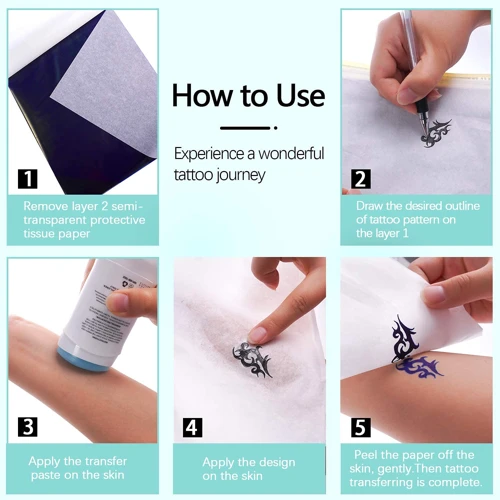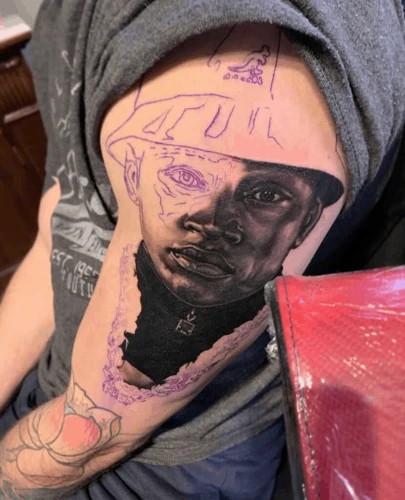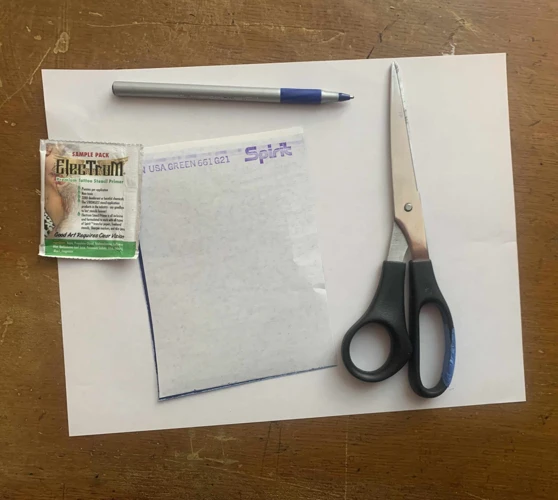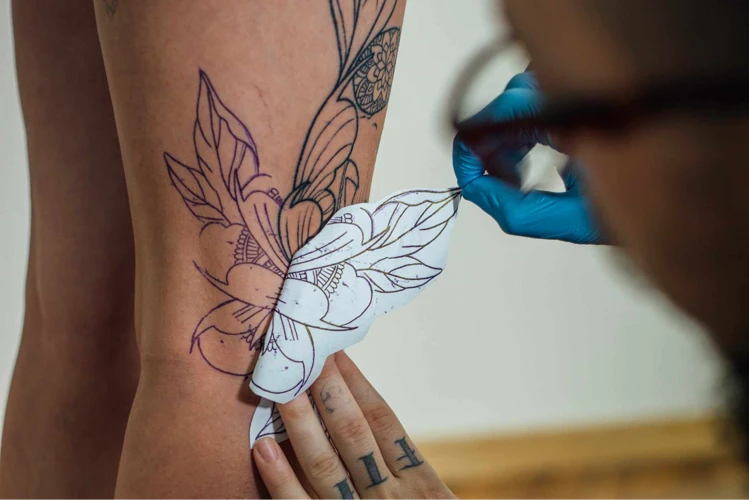Using carbon paper for tattoos is a great way to create beautiful and unique designs. This article will provide a step-by-step guide on how to use carbon paper to create your own tattoos. We’ll explain the materials and supplies you’ll need, the steps you’ll need to take, and the best practices for achieving the best results. With this guide, you’ll be able to create stunning tattoos with ease!
Contents
What is Carbon Paper and What is it Used For?

Carbon paper is a thin layer of carbon material that is used to transfer writing or drawing from one surface to another. It is typically used to make copies of documents without the need for a photocopier or printer. Carbon paper is also known as transfer paper or carbon transfer paper.
Here are some interesting facts about Carbon Paper:
- It was invented in 1806 by Ralph Wedgwood and patented for use in the United Kingdom in 1812.
- Carbon paper is made from a mixture of carbon particles and wax.
- The wax helps the carbon particles adhere to the paper surface.
- It is used in offices, schools, and homes for making copies of documents.
- In the past, it was used in typewriters to create multiple copies of the same document.
- Today, it is mostly used for making carbon copies of hand-written documents.
- It is also used in the tattoo industry as a transfer method for designs.
How to Use Carbon Transfer Paper for Tattoos:
Carbon transfer paper can be used to transfer designs, sketches, and stencils onto the skin for tattoos. To use it, the tattoo artist will first draw the design on the carbon paper and then use the carbon paper to transfer the design onto the skin. It is a simple and effective method for transferring designs onto the skin and can be used for both traditional and modern tattoos.
What is Transfer Paper and What is it Used For?

Transfer paper is a special type of paper that has a waxy coating that is designed to help you transfer images, designs, and patterns onto another surface. It is often used for creating temporary tattoos, stencils, and other art projects. It is also used in the creation of clothing and other textiles, such as quilting and embroidery.
Here’s how tattoo transfer paper works:
- A printed image is placed on the transfer paper, and then pressed onto the skin with a heated object, such as a hot iron.
- The heat helps the wax on the paper to melt and adhere to the skin.
- The image is then peeled off the skin, leaving behind the design.
Benefits of Using Transfer Paper for Tattoos:
- It is easy to use and can be done at home.
- It is cost-effective, as it does not require any professional equipment.
- The designs created with transfer paper are temporary and can be easily removed.
- It is an excellent way to practice creating tattoos before actually getting one.
How to Use Tattoo Transfer Paper at Home:
- Print the desired image onto the transfer paper.
- Cut the image out of the paper.
- Clean and shave the area of the skin where the tattoo will be applied.
- Place the cutout image onto the skin.
- Using a hot iron, press the image onto the skin for a few seconds.
- Gently peel off the paper from the skin.
Importance of Safety and Sanitation

Safety is paramount when performing any type of tattooing procedure. It is important to use sterile equipment and take every precaution to prevent infections and other potential health risks. Be sure to wear disposable gloves and a face mask while working with carbon paper to avoid coming into contact with any skin irritants.
Sanitation is also essential when using carbon paper for tattoos. Before and after each use, the carbon paper should be properly disposed of and the work area should be thoroughly cleaned and disinfected to prevent the spread of bacteria and other germs. All tools, needles, and other items used in the process should be sterilized in an autoclave before each use.
Table
| Safety | Sanitation |
|---|---|
| Wear disposable gloves and a face mask while working | Properly dispose of carbon paper after use |
| Prevent infections and other potential health risks | Thoroughly clean and disinfect work area |
| Avoid skin irritants | Sterilize tools and needles in an autoclave |
Materials Needed

- Carbon paper for transferring a design onto the skin
- Tattoo gun for the actual tattooing process
- Needles of various sizes, depending on the desired effect
- Inks in a range of colors and shades
- Antiseptic such as rubbing alcohol or hydrogen peroxide, to clean the area and reduce the risk of infection
- Cotton swabs or wipes for cleaning the skin before and after the tattooing procedure
- Bandages or plastic wrap for protecting the skin after the procedure
- Barrier film for protecting the client from the tattoo gun
Step-by-Step Instructions

- Prepare the Skin: Make sure the skin is clean and dry. Shave off any hair, and exfoliate the area with a mild scrub. Apply a thin layer of lotion or moisturizer.
- Cut the Carbon Paper: Cut the carbon paper into the desired size and shape, leaving enough room for the tattoo.
- Position the Carbon Paper: Position the carbon paper on the skin, with the ink-coated side facing down. Secure it in place with a piece of tape.
- Trace the Design: Trace the design onto the carbon paper using a pen or pencil.
- Remove the Carbon Paper: Carefully remove the carbon paper. You should now see an imprint of the design on the skin.
- Transfer the Design: Use a tattoo gun to transfer the design onto the skin. Follow the instructions that come with the gun.
- Allow the Ink to Dry: Allow the ink to dry before applying a thin layer of Vaseline or a healing ointment.
Tips and Tricks

| Tip | Description |
|---|---|
| Use a dark pen | Using a dark pen is essential when transferring the design from the carbon paper to the skin as it will be easier to trace. |
| Use a light touch | When tracing the design onto the skin, use a light touch to get the best results. This will ensure that the tracing does not become too heavy or blotchy. |
| Start in the middle | When tracing the design onto the skin, it is best to start in the middle of the tattoo and work your way outwards. This will ensure that the design is symmetrical. |
| Take your time | Rushing through the process can lead to mistakes, so it is important to take your time and do a thorough job. |
Troubleshooting
1. Ink smudging or transferring onto the skin
- Check that you are using the right type of ink.
- Ensure that the skin is clean and dry before applying.
- Make sure the carbon paper is firmly pressed against the skin.
- Wipe away any excess ink.
- Allow the tattoo to dry completely before wearing clothing over it.
2. Carbon paper not transferring the design
- Check the carbon paper is not expired.
- Check the carbon paper is free of any dust or dirt.
- Make sure the design is firmly pressed against the paper.
- Check the ink is not blocking the transfer.
- Press firmly and evenly against the skin.
Frequently Asked Questions
What Materials Are Needed to Use Carbon Paper for Tattoos?
Carbon Paper: The first and most obvious material needed to use carbon paper for tattoos is carbon paper. It is a thin sheet of paper with a dark coating on one side that, when placed between two pieces of paper and pressure is applied, transfers the image from one piece of paper to the other.
Transfer Paper: Transfer paper is another material needed for using carbon paper for tattoos. Transfer paper is a special kind of paper that is designed to be used with a printer and is used to transfer the design from the computer onto the skin.
Tattoo Ink: Tattoo ink is the third material needed to use carbon paper for tattoos. This ink is specifically designed for use on the skin, and it is important to use the right kind of ink to ensure the tattoo will have a lasting effect.
Tattoo Stencil: The fourth material needed to use carbon paper for tattoos is the tattoo stencil. A stencil is a template that is used to trace the design onto the skin and it is important to make sure that the stencil is properly lined up with the carbon paper before transferring the design.
Tattoo Needle: The fifth and final material needed to use carbon paper for tattoos is the tattoo needle. This is the tool that is used to actually apply the ink onto the skin. It is important to make sure that the tattoo needle is sterile and that it is the right size for the tattoo that is being done.
Is there a specific type of carbon paper that is best for tattoos?
The type of carbon paper that is best for tattoos is a specialty paper that is specifically designed for tattooing. It is usually made of a very thin paper and has a special coating that transfers the design onto the skin. The paper should also be non-toxic and non-allergenic so that it does not irritate the skin. This paper is best used in combination with a thermal transfer machine, which helps to ensure the image is accurately transferred.
How long will the carbon paper last on the skin?
The carbon paper will last on the skin for up to a few days. Here are some tips to help you keep your carbon paper tattoo longer:
- Ensure the skin is clean and dry before applying the carbon paper.
- Use plenty of water to keep the skin moist while the carbon paper is on.
- Avoid scratching or rubbing the tattoo while the carbon paper is on.
- Keep the tattoo out of direct sunlight and away from heat sources.
- Gently remove the carbon paper by peeling it away from the skin.
By following these steps, your carbon paper tattoo should last up to a few days.
Is there a risk of the carbon paper transferring the tattoo design to other parts of the body?
Using carbon paper for tattoos is generally considered safe, however there is a risk of the design transferring onto other parts of the body. To avoid this, make sure to wash your skin carefully before and after the tattoo is applied. Additionally, you should cover the area of skin where the tattoo will be applied with a layer of petroleum jelly or Vaseline. This will help to prevent the design from smearing. Also, make sure to remove the carbon paper immediately after the tattoo is finished.
What are the Best Practices for Removing the Carbon Paper from the Skin?
Gently wipe away the carbon paper: Using a damp cloth, gently wipe away the carbon paper residue from the skin. Be careful not to scrub too hard as this can irritate the skin.
Clean the area with water: Rinse the area with lukewarm water to remove any remaining carbon paper residue.
Use a moisturizer: Use a light moisturizer to soothe and hydrate the skin. This will help to prevent any irritation and keep the area hydrated.
Conclusion
Carbon paper is a useful tool for creating Tattoos, allowing artists to create stencils quickly and easily. With the right supplies and proper technique, Carbon paper can help make the tattooing process more efficient and enjoyable. Following the step-by-step guide provided, anyone can use Carbon paper to create professional-looking tattoos.